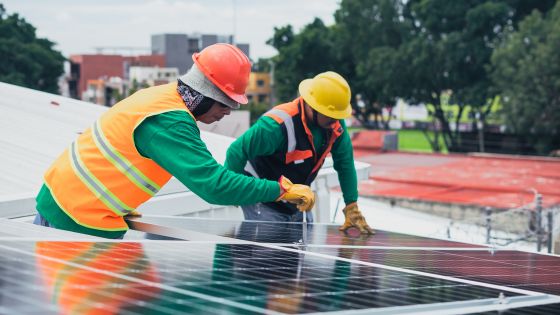“Seeing is believing.” This age-old adage holds true in almost every field. And when it comes to the solar industry, visualizing things from a bird’s-eye view becomes imperative for contractors and installers. The use of aerial imagery has revolutionized the way solar projects are planned, designed, installed, and maintained. It enables professionals to visualize everything from an elevated perspective and take better decisions based on accurate data.


Aerial images provide detailed information about rooftops, shading patterns, land topography, weather conditions, etc., that help solar contractors make informed decisions about site selection, panel placement, orientation, tilt angles, cable routing, and more. Moreover, with advancements in technology such as drones and satellites capable of capturing high-resolution images at regular intervals; solar companies can now monitor their sites remotely and detect any issues before they become catastrophic. In this article, we explore how using aerial imagery for solar contractors can enhance and streamline their operations through improved planning and monitoring capabilities.
Benefits Of Aerial Imagery For Solar Contractors
Aerial imagery has proven to be a valuable tool for solar contractors. It allows them to gain a comprehensive overview of the project site, which in turn helps with initial assessments and designing layouts. With aerial imagery, contractors can easily identify potential obstacles such as trees or buildings that could obstruct the sun’s rays, enabling them to plan accordingly. Moreover, they can quickly determine if a location is suitable for installing solar panels based on its orientation to the sun.
Another benefit of using aerial imagery is improved accuracy when it comes to measuring distances and dimensions. This technology provides high-resolution images that enable accurate measurements without any physical contact with the structures. Additionally, these images help reduce errors in calculations during planning phase as well as increase efficiency by reducing time spent performing manual measurements on-site.
Finally, aerial imagery also improves communication between teams involved in solar projects. By having access to detailed visuals of the project site, everyone from architects and engineers to construction workers will have a better understanding of what needs to be done and how it should be executed. The ability to visualize design plans before starting work saves time and resources while empowering all team members involved in the entire life cycle of the project.
Transitioning into ‘planning and designing solar projects with aerial imagery,’ this technology enables contractors to create more precise blueprints with accurate topographic data points gathered through drones or other unmanned aircraft systems (UAS).
Planning And Designing Solar Projects With Aerial Imagery
As the sun rises and sets each day, so too does the world of solar energy continue to evolve. With new technologies emerging regularly, it is essential for contractors to stay ahead of the curve if they wish to remain competitive in this ever-changing industry. Aerial imagery has proven itself as an invaluable tool that can significantly enhance a contractor’s efficiency by providing them with accurate data about potential solar project locations.
When planning and designing solar projects, aerial imagery allows contractors to see every detail of the site from above, giving them a bird’s eye view of any potential obstacles or challenges that may arise during installation. By utilizing high-resolution maps and images, contractors can evaluate various factors such as shading analysis, slope calculations, and orientation assessments quickly and efficiently. This information allows them to design systems that are optimized for maximum output while minimizing costs associated with materials and labor.
Furthermore, one significant advantage of using aerial imagery is its ability to help with panel placement decisions. By analyzing terrain features such as topography and vegetation cover, contractors can ensure that panels are installed in areas where they will receive optimal sunlight throughout the day. This not only maximizes energy production but also increases system efficiency over time by reducing wear on equipment due to overheating or other issues caused by improper placement. Overall, the use of aerial imagery has revolutionized how we approach solar contracting – enabling us to do more with less while delivering superior results for clients across all sectors!
Utilizing Aerial Imagery For Site Selection And Panel Placement
Aerial imagery has become an invaluable tool in the solar industry, particularly when it comes to site selection and panel placement. With high-quality aerial images, solar contractors can accurately assess potential sites for suitability based on factors like shading, tree cover, topography, and other features that could affect energy production. This data allows them to make informed decisions about where to install panels and how best to optimize their performance.
Aerial imagery also provides a bird’s-eye view of the entire project area, allowing contractors to identify any obstacles or hazards that may pose a risk during installation or maintenance. For example, if there are nearby power lines or buildings that could interfere with panel placement or cause safety concerns during installation, this information can be identified early on and taken into account during planning stages. Additionally, aerial imagery can help pinpoint areas where additional infrastructure may be needed to support the solar system’s electrical output.
Overall, utilizing aerial imagery for site selection and panel placement is an efficient way for solar contractors to save time and resources while ensuring optimal energy production from each project. By analyzing detailed satellite maps before beginning construction work at a new site, they can develop more accurate plans based on real-time data rather than relying solely on outdated physical surveys or guesswork. In turn, this leads to fewer errors in equipment positioning and better overall efficiency throughout the life cycle of the solar array.
Transition: While using aerial imagery for site selection and panel placement is beneficial for optimizing installations in the first place; monitoring systems post-installation through remote sensing technology will ensure longevity of both panels and supporting infrastructure alike.
Monitoring And Maintaining Solar Projects With Aerial Imagery
As solar energy becomes increasingly popular, the demand for efficient and effective monitoring and maintenance of solar projects has also grown. One way to enhance these processes is through the use of aerial imagery technology. By utilizing drones or satellites, solar contractors can gain a bird’s eye view of their projects, allowing for detailed analysis and quick identification of any potential issues.
Through regular monitoring with aerial imagery, solar contractors can identify problems before they become major issues. For example, if a panel is not functioning properly or there are shading issues due to nearby structures, it can be quickly identified from above and addressed immediately. This saves time and money in the long run by avoiding costly repairs or replacements that would have been necessary had the issue gone unnoticed.
Furthermore, advancements in aerial imagery technology for the solar industry continue to make this process even more efficient. With improved resolution and accuracy of images captured by drones or satellites, as well as increased automation in data processing, solar contractors can now easily analyze large amounts of data without having to physically inspect every single panel on site. As a result, they can focus on addressing specific problem areas instead of spending hours manually combing through data.
As we continue to see advancements in aerial imagery technology for the solar industry, it is clear that this tool will only become more crucial in improving efficiency and effectiveness in monitoring and maintaining solar projects.
Advancements In Aerial Imagery Technology For The Solar Industry
The solar industry has been utilizing aerial imagery technology to enhance its efficiency. The latest advancements in this field have enabled solar contractors to gather valuable data, such as roof pitch, shading analysis, and accurate measurements of roofs’ dimensions. These developments allow professionals to save time during site visits since they can obtain important information remotely.
One of the most significant advantages that come with using aerial imagery technology is cost savings. Instead of sending a team of professionals to conduct manual inspections on rooftops, companies can access high-resolution images obtained from drones or satellites. This approach also reduces safety risks associated with climbing onto roofs and provides greater accuracy than traditional methods.
Moreover, aerial imagery technology enables solar contractors to identify potential issues before installation begins. By analyzing detailed images captured from different angles, professionals can detect any obstacles or shading patterns that may affect the system’s performance. With this information at hand, they can make informed decisions on how best to design and install the solar panels while maximizing energy production.
Overall, these recent technological advancements demonstrate the benefits of integrating aerial imagery into the solar installation process. As more companies adopt these tools, we can expect even further optimization of their operations and enhanced productivity within the industry.
Conclusion
Aerial imagery is becoming an increasingly essential tool for solar contractors looking to enhance their efficiency. This technology has numerous benefits, including aiding in the planning and design of solar projects, facilitating site selection and panel placement, and allowing for more effective monitoring and maintenance once a project is completed. Additionally, advancements in aerial imagery technology are continually being made specifically targeted at the solar industry.
One interesting statistic that highlights how important aerial imagery has become is that according to research by MarketsandMarkets, the global market for drone services was valued at $4.4 billion in 2018 and is projected to reach $63.6 billion by 2025. As such, it is clear that utilizing aerial imagery will be crucial for solar contractors who want to remain competitive in a rapidly evolving renewable energy sector. By embracing this technology fully, they can streamline their operations, reduce costs, improve safety on job sites, and ultimately deliver better results for clients seeking sustainable energy solutions.


























